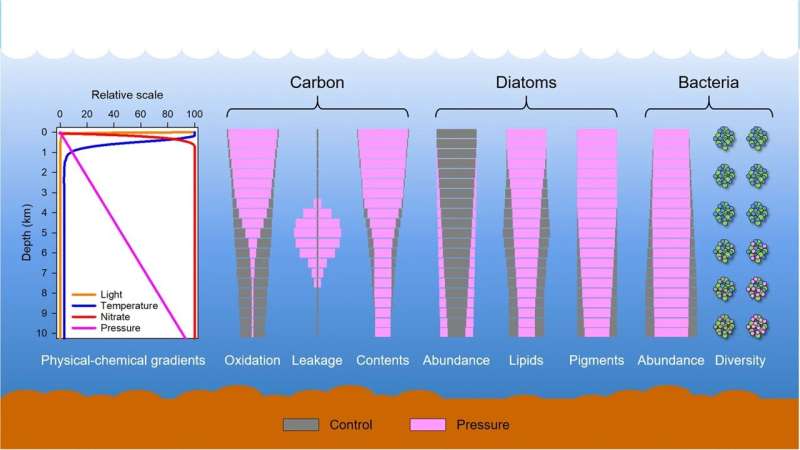This article has been reviewed according to Science X's editorial process and policies. Editors have highlighted the following attributes while ensuring the content's credibility:
fact-checked
peer-reviewed publication
trusted source
proofread
Deep-sea pressure found to preserve food for microbes in the abyss

A new study from the Danish Center for Hadal Research reports on a series of experiments with exposing marine snow to increasing pressure—up to 1000 bar, which corresponds to the pressure at the bottom of some of the world's deep-sea trenches, 10 km below the sea surface.
Marine snow is millimeter-sized flakes, created when sticky, dead cells at the sea surface clump together with other dead or dying cells, particles, and bacteria and sink to the bottom. The organic material can be dead algae, dead small animals, or their feces. Together, it is called marine snow because the flakes look like snow as they sink through the water column. There can be hundreds of different bacteria in one flake in addition to particles of organic matter.
"Not much is known about how marine snow responds to the increasing pressure when it sinks. However, it is known that marine snow is food for many microbes and small animals on the seabed. In fact, there are more microbes in the part of the ocean that lies at or below 1000 meters depth than anywhere else on Earth," says biologist Peter Stief, the lead author of the study.
"This habitat is extremely large, and there can be a long distance between the microbes down there, but nevertheless, a huge number of Earth's organisms thrive under high pressure, and we don't know how,"
Other authors are Ronnie N. Glud, Clemens Schauberger, Kevin W. Becker, Marcus Elvert, John Paul Balmonte, Belén Franco-Cisterna and Mathias Middelboe. The study is published in the journal Communications Earth & Environment.
In addition to the marine snow bringing nutrients such as organic carbon, nitrogen, sulfur, and phosphate down to the microbes in the deep, it also contributes to the burial of huge amounts of carbon in the seabed. This happens when an alga during its lifetime absorbs CO2 from the atmosphere, dies, and sinks to the bottom, taking the carbon with it. Most marine snow is eaten by animals or broken down by microbes, but a small part is stored on the sea floor.
"Perhaps only 1% of the marine snow gets stored on the seabed. But over time, it accumulates to huge amounts. The oil and gas we are currently extracting is largely created in this way," says Peter Stief.
Organic matter also reaches the deep-sea microbes in other ways. Data from a number of deep-sea expeditions carried out by the Danish Center for Hadal Research have shown that large sediment slides can occur on slopes in the deep sea. Such sediment slides can instantly send large amounts of nutrient-rich sediment down into the deepest trenches.
Now, Peter Stief and colleagues show that another mechanism also ensures that organic matter can reach the deep.
In the basement under University of Southern Denmark, the hadal researchers have pressure tanks for experiments. The tanks can withstand 1000 bar pressure, corresponding to the pressure at a depth of 10 km.
The team filled five pressure tanks with seawater and flakes of marine snow that they had made from diatoms and bacteria. Each flake was approx. 2 mm in diameter. By letting the pressure tanks rotate horizontally all the time, the researchers ensured that the flakes remained sinking in water without reaching the bottom of the tank, thus simulating the constant sinking of the flakes. Every day, they increased the pressure in the tanks by 50 bar to simulate the pressure at ever-increasing depths.
After four days, the flakes were under 200 bar pressure, corresponding to an ocean depth of 2 km. Then, the researchers opened the first tank to see how the flakes did. The same is true after 400 bar pressure, 600 bar pressure, 800 bar pressure, and the last one after 1000 bar pressure.
"We could see that the bacteria's respiration decreased as pressure increased; this means that they 'ate' less organic carbon. At 600 bar, respiration stopped completely and remained so all the way down to 1000 bar pressure, where approx. half of a flake remained—and thus food for the pressure-adapted seabed microbes," says Peter Stief.
More information: Peter Stief et al, Hydrostatic pressure induces transformations in the organic matter and microbial community composition of marine snow particles, Communications Earth & Environment (2023). DOI: 10.1038/s43247-023-01045-4
Journal information: Communications Earth & Environment
Provided by University of Southern Denmark




















